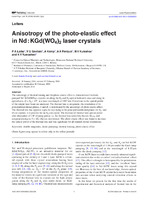| dc.description.abstract | The anisotropy of thermal lensing and the photo-elastic effect is characterized for diodepumped Nd : KGd(WO4)2 crystals cut along the Np and Ng optical indicatrix axes and along its optical axis, O = Ng + 43°, at a laser wavelength of 1067 nm. Distortions in the spatial profile of the output laser beam are analyzed. The thermal lens is astigmatic; the orientation of its principal meridional planes, A and B, is determined by the anisotropy of photo-elastic effect. The thermal lens has opposite signs for rays lying in the principal meridional planes for Np- and O-cut crystals; it is positive for an Ng-cut crystal. The increase of thermal lens optical power after absorption of 1 W of pump power, i.e. the thermal lens sensitivity factors MA(B), and astigmatism degree S = |MA–MB| are determined. The photo-elastic effect was found to increase the optical power of the thermal lens and was significant for all studied crystal orientations. | en |

